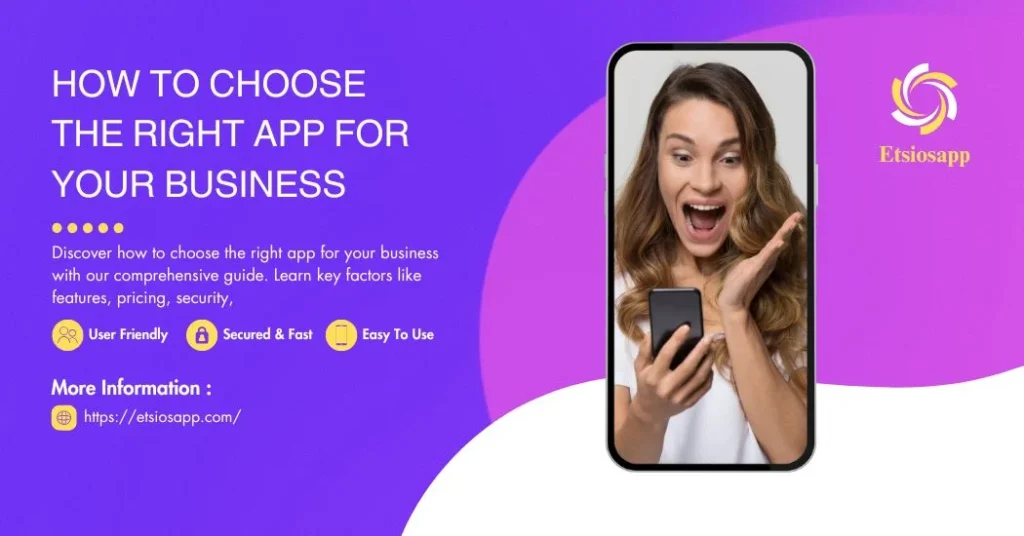In today’s fast-paced digital landscape, choosing the right app for your business is more critical than ever. With the wide variety of apps available, it can be overwhelming to decide which one best suits your business needs. Whether you’re looking for a CRM tool, project management software, or a mobile app to engage customers, selecting the right app can make a significant impact on your business’s efficiency and growth.
In this guide, we’ll walk you through the essential steps to help you make an informed decision when choosing an app for your business.
Why Choosing the Right App is Crucial for Your Business
Selecting the right app can streamline your operations, increase productivity, and enhance customer satisfaction. The wrong app, on the other hand, can lead to wasted resources, employee frustration, and missed opportunities.
Before diving into the selection process, it’s essential to understand the types of apps that might benefit your business. These include:
- Productivity apps for project management and collaboration
- Customer relationship management (CRM) apps for managing interactions with clients
- Marketing apps for automating campaigns and analytics
- Financial management apps for budgeting and tracking expenses
With so many options, how do you know which one is the best fit for your company? Let’s break it down.
Step 1: Identify Your Business Needs
Understand Your Pain Points
Before exploring app options, identify the challenges or gaps within your current business operations. Is your team struggling with communication? Are you finding it difficult to track customer data? Do you need a better way to manage finances or project timelines?
Take time to analyze your workflow, identify bottlenecks, and clarify the specific problems you’re looking to solve. This will guide you in selecting the right category of apps—whether it’s project management, CRM, or something else entirely.
Define Your Goals
Once you know the pain points, set clear goals for what you want the app to achieve. These goals could include improving team collaboration, automating certain business processes, or improving customer satisfaction. A well-defined goal helps you filter out apps that don’t align with your needs.
Step 2: Assess the Features and Functionality
When selecting the right app, evaluate its features and how they align with your business goals. Look for key functionalities such as:
- User-friendliness: Is the app easy to navigate? A complicated interface can waste time and lead to frustration.
- Customization options: Does the app offer the flexibility to adapt to your specific business processes?
- Integration capabilities: Can the app integrate seamlessly with other tools you’re already using (like email marketing platforms, accounting software, or social media)?
- Scalability: Will the app be able to grow with your business as you expand?
Make a checklist of essential features that the app must have and cross-check each option against your requirements.
Step 3: Evaluate the App’s User Experience (UX)
An intuitive user experience (UX) is crucial for any business app. A seamless, easy-to-navigate interface can reduce training time, minimize errors, and increase employee satisfaction.
- Mobile compatibility: In today’s mobile-first world, check if the app is optimized for smartphones and tablets. This is especially important for businesses that operate remotely or have employees working on-the-go.
- Customer support: Does the app offer adequate customer service and resources like tutorials or live chat? 24/7 support can be a lifesaver if you encounter technical difficulties.
Step 4: Review Security and Privacy Measures
Security is paramount, particularly for businesses handling sensitive customer data or financial information. Ensure the app you choose complies with relevant data protection regulations like GDPR or CCPA.
- Data encryption: The app should offer secure data encryption to protect sensitive business information.
- User permissions: Ensure you can manage user access and permissions to control who sees and edits specific data.
- Regular updates: Check if the app is regularly updated to fix security vulnerabilities.
Prioritize apps that invest in robust security protocols to safeguard your business data.
Step 5: Compare Pricing and Budget
Pricing is a key consideration when choosing the right app for your business. While some apps offer free versions, others charge a monthly or annual subscription. Determine your budget and evaluate the cost-benefit of each app.
- Free trials: Many apps offer a free trial period. Take advantage of these trials to test out the app’s functionalities and see if it’s the right fit.
- Tiered pricing: Some apps have tiered pricing based on the number of users or features. Make sure you choose a plan that offers scalability without overextending your budget.
A good app should provide clear pricing and a transparent return on investment (ROI). Avoid hidden costs that could add up over time.
Step 6: Look for Customer Reviews and Case Studies
Checking customer reviews and case studies is an excellent way to assess the credibility of an app. Search for feedback on third-party platforms like G2, Capterra, or Trustpilot.
Look for apps with:
- Positive reviews from businesses similar to yours
- Case studies demonstrating success stories
- A track record of reliability and performance
This will give you insight into the app’s real-world performance, customer satisfaction, and the level of support provided.
Step 7: Make an Informed Decision
After carefully evaluating all the factors above, you should be in a good position to make a final decision. Ensure that the app you choose aligns with both your short-term needs and long-term goals. Consider the app’s ability to scale, ease of use, customer feedback, and overall cost.
Frequently Asked Questions (FAQ)
1. What types of apps are essential for small businesses?
Small businesses often benefit from productivity apps like project management tools (e.g., Trello or Asana), accounting software (e.g., QuickBooks), and CRM systems (e.g., HubSpot). These apps help streamline operations, manage customer relationships, and keep track of finances.
2. How do I know if an app is trustworthy?
Look for apps with strong user reviews, security certifications, and clear privacy policies. Check if they follow industry standards like GDPR or ISO/IEC certifications for data protection.
3. What’s the best way to test an app before committing?
Take advantage of free trials and demo versions. Test the app’s features, ease of use, and integration with your existing tools during the trial. Involve team members in the testing process to ensure it meets everyone’s needs.
4. Are there apps that offer both desktop and mobile versions?
Yes, many apps today offer both desktop and mobile versions, allowing you to work from anywhere. Popular apps like Slack, Trello, and Google Workspace have seamless desktop and mobile integration.
Explore the best MMP apps to streamline your mobile marketing efforts and enhance campaign performance.







